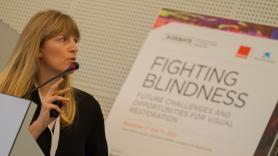3. The greatest promises: gene therapy and stem cells
Gene therapy
Gene therapy mainly consists in modifying the genetic makeup of the cells to correct a mutation or to give them an advantage to allow them to overcome a defect. It is one of the greatest hopes for many diseases, although for now there is only one type of gene therapy in Europe that has gained approval and it has nothing to do with blindness. It has to do with a type of disease related to the metabolism of fat.
In fact, as explained Francisco J. Díaz Corrales, researcher at the Andalusian Molecular Biology and Regenerative Medicine Center (CABIMER), up to “65% of clinical trials with gene therapy have been done in cancer patients, and only 2% in patients with visual deficits.” However, the eye is a promising organ for this type of therapies. Gema Martín Navarrete, postdoctoral researcher at Miguel Hernández University of Elche, agreed, “Because it is small, isolated and immunoprivileged” (which lessens the chances of immune rejection of the therapy).
"The eye is a promising organ for gene therapies"
One of the problems facing gene therapy is the risks it may imply. Implanting genes into cells is normally done with viruses that go into the nucleus and insert them into the DNA. But it is very difficult to control where they do this, which can lead to undesired mutations. Scientists are working to improve safety and on new formulas like niosomes, a nanotechnology version of the well-known liposomes. And a new repair technology promises to change the future of gene therapy, whether administered by a virus or with nanotechnology. It is called CRISPR/Cas9, and was chosen the most important scientific breakthrough of 2015.
So far, the gene therapy that is the furthest along, which has already been proven to fight blindness, focuses on a hereditary disease called Leber's congenital amaurosis. Trials are in the pre-approval phase and the therapy has already been tested on 50 patients. According to Díaz Corrales, so far “It has proven safe and effective.” There's only one mutated gene in this illness, so the design therapy is clear. It would be more difficult in multi-factor pathologies, where there is no specific gene, such as AMD. But it hasn’t been discarded. According to Monés, surely “They are moving towards boosting a protection factor.” Díaz Corrales’ own group is working with this hypothesis on gene SIRT1, a sort of nucleus where several mechanisms involved come together.
Stem-cell transplants
Clinical trials with stem cells to treat various types of blindness began in 2010. And, although no therapies have yet been approved for any sort of visual deficit, “There are currently many clinical trials underway, most with embryonic stem cells,” explained Anna Veiga, director of the Stem Cell Bank at the Center of Regenerative Medicine in Barcelona.
Embryonic cells are one of the types that can be used. But there are more: including those called induced pluripotent stem cells (IPS), which are created by reprogramming mature cells to make them into stem cells. These are one of the greatest hopes, although they also have their difficulties. As explained Michael Edel, researcher at the University of Barcelona, these include clarifying issues like “the possibility that they will become tumor cells, knowing whether they provoke an immune response and standardizing and optimizing production protocols.” This isn't a trivial issue: a trial with the sort of cells to treat macular degeneration had to be halted due to safety issues, as some of the cells had mutations in genes that could cause cancer (oncogenes).
These cells would be used to replace the damaged ones, as they can mature and substitute those that no longer work to restore lost functions. This is why it's is called replacement therapy. But there are other options: mesenchymal cells, which come from bone marrow, can also be used. These cells could be used in the earliest stages, as they have protective and stimulating properties that would slow the development of the disease.
"It is a long, exciting road that will probably lead to a combination of these experimental therapies. For the moment, though, we have to test and study them separately"
And there are even more futuristic therapies being studied. These include reprogramming cells directly in vivo. This is what they are working on in the laboratory of Pia Cosma, ICREA professor at the Center for Genomic Regulation in Barcelona. To do so, they inject ‘activated’ stem cells that go to the retina of rats with pigmentary retinitis and merge with damaged cells. This creates cells that, initially, have two nuclei and seem to regenerate the injured photoreceptors, restoring part of their vision.
As Jordi Monés said, “It is a long, exciting road that will probably lead to a combination of these experimental therapies. For the moment, though, we have to test and study them separately.”



